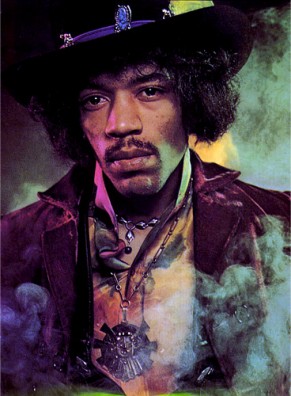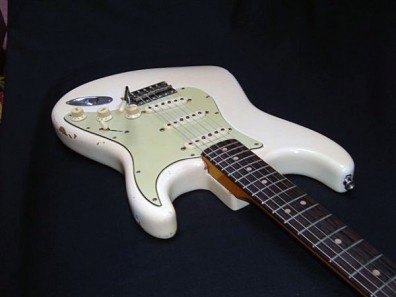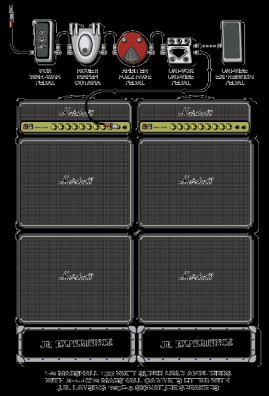Jimi Hendrix Life, Times & Fire
Guitars
Hendrix owned and used a variety of guitars during his career. His guitar of choice, however, and the instrument that became most associated with him, was the Fender Stratocaster, or “Strat.” He started playing Stratocasters in 1966 and thereafter used it almost exclusively for his stage performances and recordings.
Hendrix bought many Strats and gave some away as gifts. The original sunburst Stratocaster that Hendrix burnt at the Astoria in 1967, and that he kept as a souvenir, was given to Frank Zappa by a Hendrix roadie at the 1968 Miami Pop Festival; Zappa assumed it was the one Hendrix had played there.
Hendrix used right-handed guitars, turned upside down for left-hand playing, and restrung so that the heavier strings were in their standard position at the top of the neck. This had an important effect on his guitar sound: because of the slant of the Strat’s bridge pickup, his lowest string had a bright sound while his highest string had a mellow sound, the opposite of the Stratocaster’s intended design.
Heavy use of the tremolo bar necessitated frequent tuning; Hendrix often asked the audience for a “minute to tune up.” In addition to Fender Stratocasters, Hendrix was also photographed playing Jazzmasters, Duosonics, two different Gibson Flying Vs, a Gibson Les Paul, three Gibson SGs, a Gretsch Corvette he used at the 1967 Curtis Knight sessions and miming with a right strung Fender Jaguar on the “Top Of The Pop’s” TV show, as well as several other brands. Hendrix borrowed a Fender Telecaster from Noel Redding to record “Hey Joe” and “Purple Haze”, used a white Gibson SG Custom for his performances on the Dick Cavett show in the summer of 1969, and the Isle of Wight film shows him playing his second Gibson Flying V. While Jimi had previously owned a Flying V that he’d painted with a psychedelic design, the Flying V used at the Isle of Wight was a unique custom left-handed guitar with gold plated hardware, a bound fingerboard and “split-diamond” fret markers that were not found on other 60s-era Flying Vs.
Amplifiers And Some…
Hendrix was a catalyst in the development of modern guitar effects pedals. His high volume and use of feedback required robust and powerful amplifiers. For the first few rehearsals he used Vox and Fender amplifiers. Sitting in with Cream, Hendrix played through a new range of high-powered guitar amps being made by London drummer turned audio engineer Jim Marshall, and they proved perfect for his needs. Along with the Stratocaster, the Marshall stack and amplifiers were crucial in shaping his heavily overdriven sound, enabling him to master the use of feedback as a musical effect, and he created a “definitive vocabulary for rock guitar.”
While his mainstays were the Arbiter Fuzz Face and a Vox wah-wah pedal, Hendrix experimented with guitar effects as well. He had a fruitful association with engineer Roger Mayer who later went on to make the Axis fuzz unit, the Octavia octave doubler and several other devices based on units Mayer had created or tweaked for Hendrix. The Japanese-made Univibe, designed to simulate the modulation effects of the rotating Leslie speaker, provided a rich phasing sound with a speed control pedal, and is heard on the Band of Gypsys track “Machine Gun,” which highlights use of the univibe, octavia and fuzz face pedals.
The Hendrix sound combined high volume and high power, feedback manipulation, and a range of cutting-edge guitar effects. He was also known for his trick playing, which included playing with only his right (fretting) hand and using his teeth or playing behind his back and between his legs. Hendrix had large hands and characteristically used his thumb to fret bass notes, leaving his fingers free to play melodic fills on top, so he could play lead and rhythm parts simultaneously. This technique was made easier by his Stratocaster’s 7.25″ fingerboard radius (more rounded than the modern standard 9.5″). A clear demonstration of this thumb technique can be witnessed in the Woodstock video; during the song “Red House” there are excellent close-ups of Hendrix’s fretting hand.

The End
Early on September 18, 1970, Jimi Hendrix died in London under circumstances which have never been fully explained. He had spent the latter part of the previous evening at a party and was picked up by girlfriend Monika Dannemann and driven to her flat at the Samarkand Hotel, 22 Lansdowne Crescent, Notting Hill. According to the estimated time of death, from autopsy data and statements by friends about the evening of September 17, he would have died within a few hours after midnight, though no precise estimate was made at the original inquest.
Dannemann claimed in her original testimony that after they returned to her lodgings the evening before, Hendrix, unknown to her, had taken nine of her prescribed Vesperax sleeping pills. The normal medical dose was half a tablet, but Hendrix was unfamiliar with this very strong German brand. According to surgeon John Bannister, the doctor who initially attended to him, Hendrix had asphyxiated in his own vomit, mainly red wine, which had filled his airways, as the autopsy was to show. For years, Dannemann publicly claimed that she had only discovered that her lover was unconscious and unresponsive sometime after 9am, that Hendrix was alive when placed in the back of the ambulance after half past eleven, and that she rode with him on the way to the hospital; the latter two are denied by the ambulance crew. However, Dannemann’s comments about that morning were often contradictory, varying from interview to interview. Police and ambulance statements reveal that there was no-one but Hendrix in the flat when they arrived at 11:27am, and not only was he dead when they arrived on the scene, but was fully clothed and had been dead for some time.
Later, Dannemen claimed that former road managers Gerry Stickels and Eric Barrett had been present before the ambulance was called and had removed some of Hendrix’s possessions, including some of his most recent messages. Lyrics written by Hendrix, which were found in the apartment, led Eric Burdon to make a premature announcement on the BBC-TV program 24 Hours that he believed Hendrix had committed suicide. Burdon often claimed he had been telephoned by Dannemann after she discovered that Jimi failed to wake up.
Following a libel case brought in 1996 by Hendrix’s long-term English girlfriend Kathy Etchingham, Monika Dannemann committed suicide, though her later lover, Uli Jon Roth, has made accusations of foul play.
Discography
The Jimi Hendrix Experience
Are You Experienced (1967)
Axis: Bold as Love (1967)
Electric Ladyland (1968)
Jimi Hendrix/Band of Gypsys
Band of Gypsys (1970) (live)
Posthumous Studio Albums
The Cry of Love (1971)
Rainbow Bridge (1971)
War Heroes (1972)
Loose Ends (1974)
Crash Landing (1975)
Midnight Lightning (1975)
Nine to the Universe (1980)
Radio One (1988)
First Rays of the New Rising Sun (1997)
South Saturn Delta (1997)
Valleys of Neptune (2010)
Fire. The Jimi Hendrix Collection (2010)
|
|

|

Bellowhead |
LATEST GALLERY IMAGES

The Price of Food 
The Invisible Enemy |
|
|




